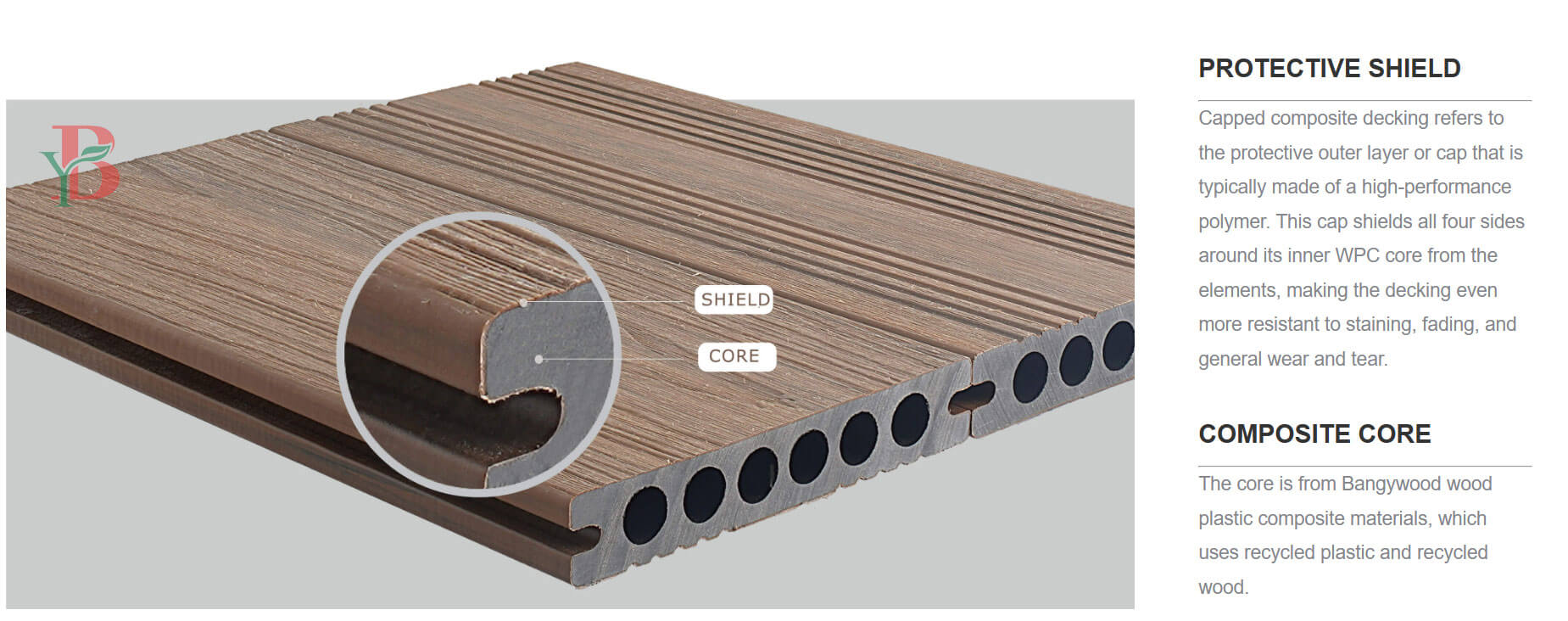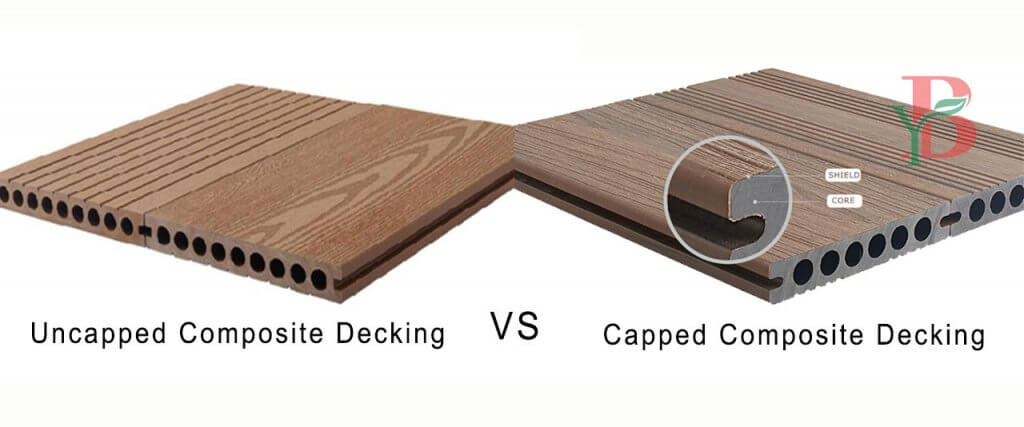However, within the world of composite decking, capped or uncapped composite decking is always confused to the homebuilders which one to choose? The choice between capped and uncapped composite decking is important decision for homebuilders, as it can significantly impact the longevity, aesthetics, and overall satisfaction of homeowners. In this article, we will delve into the details of capped and uncapped composite decking, to compare the benefits and drawbacks of each. So you will well-equipped to make decisions.
What is Composite Decking?
Composite decking (also called wood-plastic composite, or WPC) is an eco-friendly alternative to wood decking. Whether capped or uncapped, Bongywood composite decking is made primarily from recycled wood flour and recycled plastic polymers.
Homebuilders appreciate the numerous advantages that composite decking brings to their projects. These include:
- Longevity: Composite decking has a considerably longer lifespan than wood. It resists rot, decay, and insect damage, ensuring that the outdoor space remains inviting for decades.
- Low Maintenance: Unlike wood, composite decking doesn’t require staining, sealing, or regular painting. It only needs periodic cleaning with soap and water to maintain its pristine appearance.
- Eco-Friendly: Many composite decking products utilize recycled materials in their production, reducing the environmental impact.
- Weather Resistance: Composite decking handles diverse climates and weather conditions with ease, staying robust in the face of extreme heat, cold, or moisture.
Introduction to Capped Composite Decking
Capped Composite Decking, which is also called Co-extrusion Decking in China, is the industry’s most advanced products of extrusion molding technology. Capped composite decking, as the name suggests, incorporates an additional protective cap layer over the core composite material. This cap layer serves a crucial role in enhancing the performance of the decking boards.
The cap layer in capped composite decking offers multiple advantages:
- Moisture Resistance: By preventing water absorption, the cap layer shields the core composite from moisture, making it exceptionally resistant to rot, mold, and mildew.
- Color Retention: Capped composite decking boasts impressive color stability. The cap layer acts as a shield against the fading effects of prolonged exposure to UV rays, ensuring the deck’s aesthetic appeal for years.
- Scratch and Stain Resistance: Capped composite decking is designed to withstand everyday wear and tear. It’s highly resistant to scratches and stains, making it ideal for high-traffic areas and families with pets.
- Low Maintenance: The added layer eliminates the need for sealing, staining, or frequent painting. Cleaning is typically limited to a simple soap and water wash, simplifying upkeep.
Bongywood 4-Sided Capped Composite Decking is the new generation of composite decking. It has an advanced tough plastic shield encasing all four sides around its inner WPC core, which provides added protection against the elements and everyday living. The extrusion process creates the decking with highly durable, long lasting and resistant to staining, fading, mold, termites, rot and relative impact.

Capped vs. Uncapped: Key Difference
Capped vs. uncapped, the big difference is that capped products have a “cover” that provides added protection against the elements and everyday living. It’s an important distinction to note, because earlier generations of composite decking were uncapped.
- Structural Integrity and Longevity
Capped composite decking’s protective cap layer enhances its durability, making it better equipped to endure years of use and exposure to the elements. This extended lifespan can be a significant advantage, especially when creating outdoor spaces that are expected to maintain their appeal over time.
Uncapped composite decking, while still a robust alternative to wood, may not offer the same level of resistance to moisture, stains, and UV exposure. Therefore, it might require more frequent maintenance and could have a slightly shorter lifespan in comparison to capped decking.
- Maintenance Requirements
Capped composite decking is notably low-maintenance, requiring minimal upkeep. Homeowners can enjoy the benefits of an attractive and long-lasting outdoor space without regular staining, sealing, or complex maintenance routines.
Uncapped composite decking, while easier to maintain than wood, may demand more attention to maintain its appearance. This can involve periodic cleaning, possible sealing, and addressing potential staining or color fading over time.
- Aesthetics and Customization
Capped decking often offers a broad range of wood grain patterns and colors, closely mimicking the natural appearance of wood. The cap layer enhances the depth and realism of these designs.
Uncapped decking is prized for its natural, wood-like appearance. Homeowners who prefer a more organic aesthetic may find uncapped options appealing.
Choosing the Suitable Composite Decking for the Project
There are some factors should to be considered when deciding capped or uncapped composite decking best suits the project.
- Climate and Environmental Factors
Capped composite decking’s enhanced resistance to moisture, UV exposure, and temperature fluctuations makes it an ideal choice for regions with harsh or fluctuating weather conditions. Uncapped decking can still thrive in various climates, particularly in more temperate areas.
- Customer Preferences
Some homeowners may prefer a wood-like appearance and are willing to commit to regular maintenance, making uncapped composite decking an attractive option. Others may seek a low-maintenance, durable choice that closely resembles wood, leading them toward capped composite decking.
- Application Place
Spaces with heavy foot traffic or those that require extended longevity and resistance to wear and tear, capped composite decking is often the preferred choice. However, uncapped decking may be more suited for smaller-scale projects or areas that prioritize a more natural appearance.
- Budget Considerations
While capped decking offers enhanced durability and low maintenance, it usually comes at a higher upfront cost. In some cases, the long-term cost savings of capped decking may outweigh the initial investment.
Comparison between Bongywood Capped and Uncapped Composite

| Characteristics | Uncapped Composite Decking | Capped Composite Decking |
| Durability | ★★ | ★★★ |
| Mold/Mildew Resistance | ★ | ★★★ |
| Stain Resistance | ★ | ★★★ |
| Scratch Resistance | ★ | ★★ |
| Colorfast | ★ | ★★★ |
| Splinter Free | ★★★ | ★★★ |
| Heat Dissipation | ★ | ★ |
In addition to retain the traditional composite decking moisture, rot, insects and termites resistance, but also Bongywood capped composite decking has many other advantages:
- Better resist to scratch;
- Better resist to UV, better color stability;
- Better resist to moisture and termites;
- Richer color and more variation;
- Extreme durability and reliable: less water-absorption, less rotten, wear proof;
- More durable, more fading and staining resistant, more attractive and more reliable;
- Never need sanding, staining, or refinishing, it is real low maintenance.
Conclusion
Choosing between capped and uncapped composite decking is depended on different factors, including: climate, application spaces, customer preferences and budget considerations etc. As a homebuilder, your role extends beyond constructing structures; it involves creating environments that enhance the lives of those who inhabit them. The choice between capped and uncapped composite decking provides an opportunity to do just that. By aligning the selection with the unique preferences and requirements of your clients, you can craft outdoor spaces that are both beautiful and functional, spaces that bring years of enjoyment and pride.
Bongywood Wood Plastic Composite
Guangdong Bangying New Building Materials Co., Ltd. is a professional manufacturer specializing in the R&D, production, and sales of WPC (Wood Plastic Composite) materials, our products include composite decking, capped composite decking, WPC Wall Panel, WPC Railing & Fencing, WPC Pergola & Gazebo, WPC Chairs & Bench, WPC Flower Planter Pots, etc.
Leave a Reply

